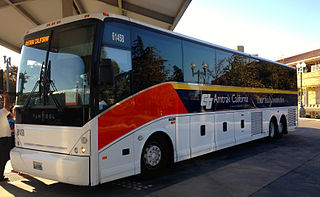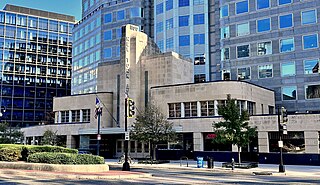
Greyhound Lines, Inc. (Greyhound) is a company that operates the largest intercity bus service in North America. Services include Greyhound Mexico, charter bus services, and Amtrak Thruway services. Greyhound operates 1,700 coaches produced mainly by Motor Coach Industries and Prevost serving 230 stations and 1,700 destinations. The company's first route began in Hibbing, Minnesota in 1914 and the company adopted the Greyhound name in 1929. The company is owned by Flix North America, Inc., an affiliate of FlixBus, and is based in Downtown Dallas.

The Seaboard Air Line Railroad, which styled itself as "The Route of Courteous Service", was an American railroad that existed from April 14, 1900, until July 1, 1967, when it merged with the Atlantic Coast Line Railroad, its longtime rival, to form the Seaboard Coast Line Railroad. Predecessor railroads dated from the 1830s and reorganized extensively to rebuild after the American Civil War. The company was headquartered in Norfolk, Virginia, until 1958, when its main offices were relocated to Richmond, Virginia. The Seaboard Air Line Railway Building in Norfolk's historic Freemason District still stands and has been converted into apartments.

Streamline Moderne is an international style of Art Deco architecture and design that emerged in the 1930s. Inspired by aerodynamic design, it emphasized curving forms, long horizontal lines, and sometimes nautical elements. In industrial design, it was used in railroad locomotives, telephones, toasters, buses, appliances, and other devices to give the impression of sleekness and modernity.

Amtrak Thruway is a system of through-ticketed transportation services to connect passengers with areas not served by Amtrak trains. In most cases these are dedicated motorcoach routes, but can also be non-dedicated intercity bus services, transit buses, vans, taxis, ferry boats and commuter rail trains.

The Richmond Staples Mill Road Amtrak station is located in unincorporated Henrico County, about 5 miles (8 km) north of downtown Richmond. The station was designed by David Volkert and Associates, and was built in 1975 as a replacement for Main Street Station in downtown Richmond, which had been heavily damaged by flooding from Hurricane Agnes. At its opening, it also inherited trains that had called at Richmond's other former union station, Broad Street Station, with a bus connection to the short-lived Richmond–Ellerson Street Station. Although limited Amtrak service returned to Main Street Station in December 2003, Staples Mill Road remains the primary rail station for the Richmond area, and all Richmond trains make a stop there. Richmond Main Street Station only sees trains that terminate there or at Newport News, since the other trains bypass downtown Richmond to the west.

Transportation in Richmond, Virginia and its immediate surroundings include land, sea and air modes. This article includes the independent city and portions of the contiguous counties of Henrico and Chesterfield. While almost all of Henrico County would be considered part of the Richmond area, southern and eastern portions of Chesterfield adjoin the three smaller independent cities of Petersburg, Hopewell, and Colonial Heights, collectively commonly called the Tri-Cities area. A largely rural section of southwestern Chesterfield may be considered not a portion of either suburban area.

Martin Luther King Jr. Plaza is the main passenger rail and intercity bus station of Toledo, Ohio.

Savannah station is an Amtrak train station in Savannah, Georgia. The station was built in 1962 to replace the older Savannah Union Station, torn down for construction of I-16. Located at 2611 Seaboard Coastline Drive, the station consists of a terminal building on the east side of the north–south tracks, with a platform between the tracks.

Kemper Street station, also known as Lynchburg station, is an intermodal transit station in Lynchburg, Virginia, United States. It serves Amtrak while an adjacent bus transfer center serves Greater Lynchburg Transit Company and Greyhound buses. Kemper Street Station is located at 825 Kemper Street.

Williamsburg Transportation Center is an intermodal transit station in Williamsburg, Virginia. Operated by the Williamsburg Area Transit Authority, it also serves Amtrak's Northeast Regional train as well as Greyhound Lines and Hampton Roads Transit intercity buses. The transportation center was formerly a Chesapeake and Ohio Railway (C&O) passenger station.
The Seaboard Air Line Depot can refer to the following former and active train stations previously used by the Seaboard Air Line Railroad, many of which are listed on the National Register of Historic Places:
The Southeastern Greyhound Lines, a highway-coach carrier, was a Greyhound regional operating company, based in Lexington, Kentucky, USA, from 1931 until 1960, when it became merged with the Atlantic Greyhound Lines, a neighboring operating company, thereby forming the Southern Division of The Greyhound Corporation, called also the Southern Greyhound Lines.
The Atlantic Greyhound Lines, a highway-coach carrier, was a Greyhound regional operating company, based in Charleston, West Virginia, USA, from 1931 until 1960, when it became merged with the Southeastern Greyhound Lines, a neighboring operating company, thus forming the Southern Division of The Greyhound Corporation, which division became called also the Southern Greyhound Lines (GL).

The Greyhound Bus Depot is a former Greyhound Lines intercity bus station in Columbia, South Carolina. It is at 1200 Blanding Street in downtown Columbia. The depot was named to the National Register of Historic Places on December 28, 1989. After the bus terminal was closed, the building became a bank. Currently, it is a physician's office.

The Old Greyhound Terminal was a bus terminal serving Greyhound Lines located at 1100 New York Avenue NW in Northwest, Washington, D.C. in the United States operating from 1940 to the 1980s. It was used extensively during World War II to transport servicemen, and played a minor role in the Civil Rights Movement. It was saved through the intervention of preservationists. Most of the building was incorporated in the new 1100 New York Avenue high-rise office building when it was built in 1991.

The Ann Arbor Bus Depot was an intercity bus station located at 116 W. Huron in Ann Arbor, Michigan. It was built in 1940 as the Eastern Michigan Motorbus Terminal, and operated as a bus station until its demolition in 2014. It was designed by the Cleveland-based architects Banfield and Cumming, in partnership with Ann Arbor architect Douglas Loree, in an Art Deco style. Between 1988 and 2001, it was listed as an Individual Historic Property on the Ann Arbor Register of Historic Places. The Bus Depot was demolished in 2014 to make way for a six-story, 110-room hotel on the property, although its facade and marquee are being preserved and will be incorporated into the new hotel. It served as Ann Arbor's Greyhound station until shortly before its demolition in 2014. It was also both the last surviving example of Streamline Moderne architecture and the last public Art Deco structure in Ann Arbor.

William Strudwick Arrasmith was an American architect known for his designs for Greyhound bus stations in the Streamline Moderne style popular in the 1930s and 1940s. Among the over 60 stations he designed are the Cleveland Greyhound Bus Station (1948), the Montgomery, Alabama, Greyhound Bus Station (1951), and the Evansville, Indiana, Greyhound Bus Terminal (1938) which are listed on the National Register of Historic Places.

The Atlantic Greyhound Bus Terminal, at 109 Martin Luther King, Jr. Blvd. in Savannah, Georgia was listed on the National Register of Historic Places in 2016.

The Atlantic Coast Line Railroad’s Main Line was the backbone of the Atlantic Coast Line Railroad's network in the southeastern United States. The main line ran from Richmond, Virginia to Port Tampa just southwest of Tampa, Florida, a distance of nearly 900 miles. Along its route it passed through Petersburg, Rocky Mount, Florence, Charleston, Savannah, Jacksonville, and Orlando. With the exception of a short 61-mile segment in Greater Orlando, the entire line is still owned by the Atlantic Coast Line's successor, CSX Transportation, and is still in service as their A Line.
























